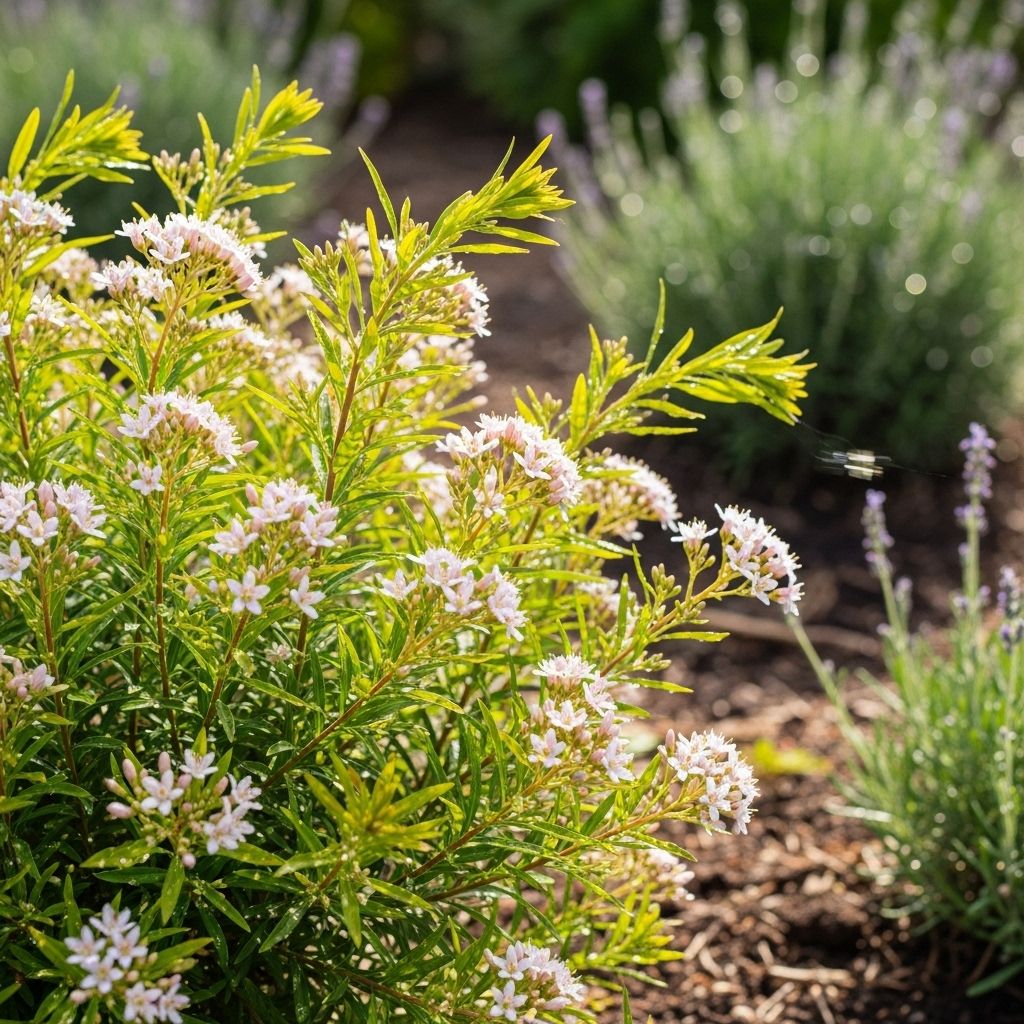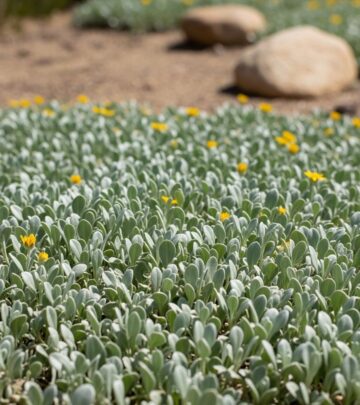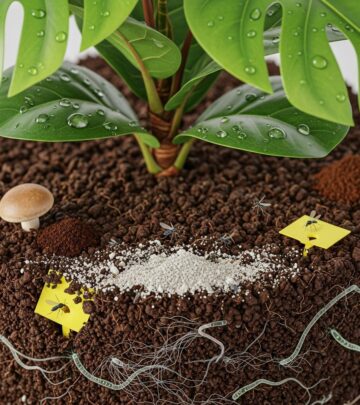Breath Of Heaven Plant Care: Complete Guide For Your Garden
Discover how this aromatic, low-maintenance South African shrub can transform your garden with heavenly fragrance

Image: HearthJunction Design Team
Getting to Know the Breath of Heaven Plant
Fragrance plays an essential role in gardening, doing more than just perfuming the air and attracting pollinators—it creates lasting memories and emotional connections to our outdoor spaces. While many gardeners focus on flowers for scent, some of the most delightful garden fragrances come from foliage. The Coleonema pulchellum, commonly known as Pink Breath of Heaven, exemplifies this perfectly with its aromatic, needle-like leaves that release a fresh, heavenly scent when touched.
The name itself evokes something magical, and experiencing this plant firsthand often creates memorable moments. Imagine brushing your hand across its soft, wispy stems and inhaling the delicate fragrance—it’s enough to make anyone wonder if heaven might indeed smell this sweet. This South African native brings more than just wonderful scent to gardens; it offers year-round structure, drought tolerance, and a profusion of tiny star-shaped pink flowers that can bloom from late winter through fall.
Plant Facts
Native to the coastal regions of South Africa, Coleonema pulchellum belongs to the Rutaceae family (the same as citrus plants), explaining its aromatic qualities. This evergreen shrub typically grows 4-6 feet tall and spreads about 5 feet wide, creating a softly rounded form in the landscape. The plant features needle-like, bright green leaves densely arranged on slender branches, giving it a feathery, almost cloud-like appearance.
What makes this plant particularly valuable is its extended blooming period. The tiny star-shaped pink flowers appear at the branch tips, creating a delicate mist of color against the green foliage. In mild climates, flowering can begin in late winter and continue through fall, providing nearly year-round interest.
Coleonema pulchellum is hardy down to about 20°F (-6°C), making it suitable for USDA zones 9-11. In colder regions, it can be grown in containers and brought indoors during winter months.
How to Use It in Your Garden
The Pink Breath of Heaven excels in gardens needing year-round structure and interest without demanding extensive maintenance or water. Its versatility allows it to blend with various garden styles, making it an excellent choice for multiple landscape applications:
- Foundation planting: Its moderate size makes it perfect for planting near home foundations where its aromatic qualities can be appreciated up close.
- Mixed borders: The fine texture contrasts beautifully with broader-leaved plants and can soften the appearance of more structured elements.
- Coastal gardens: Coleonema tolerates coastal conditions and salty air remarkably well, and its wispy form moves gracefully in ocean breezes.
- Drought-tolerant landscapes: Once established, this plant requires minimal water, making it ideal for water-wise garden designs.
- Container gardening: Its manageable size and attractive year-round appearance make it suitable for large containers on patios or entryways.
The plant’s versatility extends to design styles as well. It works equally well in cottage gardens alongside flouncy flowers as it does in more contemporary designs with succulents and architectural plants. For a pleasing combination, pair it with plants that have contrasting textures or complementary colors to enhance its delicate appearance.
Where to Plant
Choosing the right location is crucial for the success of your Coleonema pulchellum. This plant thrives in conditions similar to its native South African habitat:
Light Requirements
Plant Coleonema in full sun for best results. While it can tolerate partial shade, too little sunlight results in leggy growth and reduced flowering. In hotter regions, some afternoon shade might benefit the plant, but generally, more sun equals better performance.
Soil Conditions
This plant prefers well-drained, moderately fertile soil. Sandy or loamy soil with good drainage is ideal. Coleonema grows best in neutral to acidic soil conditions, and it will struggle in heavy clay or waterlogged areas. If your garden has heavy soil, consider planting in raised beds or amending the soil with sand and compost to improve drainage.
Spacing Considerations
When planting multiple Coleonema, space them 3 to 10 feet apart, depending on the desired effect. For a hedge-like appearance, plant them closer together (3-4 feet). For individual specimen plants with room to reach their full size, allow 5-6 feet between plants.
| Growing Condition | Requirement |
|---|---|
| Sunlight | Full sun |
| Soil Type | Well-drained, sandy to loamy, acidic to neutral |
| Water Needs | Moderate when establishing, low once established |
| Temperature | Hardy to 20°F (-6°C) |
| Spacing | 3-10 feet apart |
When to Plant
The best time to plant Coleonema pulchellum is during the cooler seasons of spring or autumn. These periods allow the plant to establish its root system without the stress of extreme temperatures. In milder climates, winter planting is also possible as long as hard frosts aren’t expected.
Container-grown plants can be transplanted any time of year if necessary, but avoid planting during the hottest summer days, as the plant will need extra attention to become established during heat waves.
Care and Maintenance
One of the most appealing aspects of Coleonema is its relatively low maintenance requirements once established. However, proper care during the establishment phase ensures long-term success.
Watering Requirements
During the first growing season, water regularly to help establish a deep, extensive root system. Once established, Coleonema becomes quite drought-tolerant, requiring only moderate watering. The key is to allow the soil to dry slightly between waterings—these plants dislike constantly wet feet.
In winter, reduce watering further, especially in regions with natural rainfall. Container-grown plants will need more consistent moisture than those in the ground but still benefit from allowing the soil to dry slightly between waterings.
Fertilizing
Coleonema isn’t a heavy feeder but benefits from some nutritional support. Apply a balanced liquid fertilizer monthly during the growing season, or use a slow-release general-purpose fertilizer in spring. For a more natural approach, top-dress around the base of the plant with well-aged compost in spring and fall, which improves soil structure while gently feeding the plant.
Pruning and Shaping
While not strictly necessary, light pruning helps maintain the plant’s shape and encourages denser growth. The best time to prune is after the main flowering period, typically in late spring or early summer. You can trim back the tips of branches to encourage bushiness or shape the plant more formally if desired.
Coleonema responds well to pruning and can even be shaped into a more formal hedge, though its natural soft, billowy form is often considered its most attractive feature. For young plants, pinching out the growing tips encourages branching and creates a fuller shape.
Seasonal Care
In regions approaching the cooler end of its hardiness range, provide some winter protection during the first year or two until the plant is well-established. This might include applying a layer of mulch around the base (keeping it away from the stem) or creating a temporary windbreak during harsh weather.
In exceptionally hot regions, providing afternoon shade and ensuring consistent moisture during heat waves helps prevent stress. A layer of mulch also helps retain soil moisture and keeps roots cooler during summer.
Pests and Problems
Fortunately, Coleonema pulchellum is generally pest and disease resistant, making it an excellent low-maintenance addition to the garden. Deer typically avoid it due to its aromatic foliage, another significant advantage in areas where deer pressure is high.
The most common issues stem from improper growing conditions rather than pests or diseases:
- Poor drainage: Roots can rot if the soil remains soggy. Ensure good drainage and avoid overwatering.
- Yellowing leaves: Often indicates nutrient deficiencies, particularly iron. Treat with an appropriate fertilizer and check soil pH.
- Sparse flowering: Usually results from insufficient sunlight or improper pruning timing. Ensure the plant receives adequate sun and avoid pruning during bud formation.
Propagation Methods
If you’d like to increase your collection of Coleonema plants, two effective propagation methods are available: seed sowing and taking cuttings.
Growing from Seed
Collect seeds from the previous year’s flowers once they’ve ripened. The optimal sowing time is autumn. Prepare a seed tray with a 50:50 mixture of sand and compost, sow the cleaned seeds on the surface, and cover with a thin layer of bark. Keep the tray consistently damp in a sheltered area with good light and ventilation. Germination typically occurs within 1-2 months.
Once seedlings develop four true leaves, carefully transplant them into individual pots. Pinch out the growing tips to encourage bushy growth, and regularly feed with a balanced nutrient solution. Seedlings may take a couple of years to reach flowering size.
Propagating from Cuttings
Taking semi-ripe cuttings in summer is often the quicker and more reliable method. Select healthy stems about 3-4 inches long, strip the lower leaves, and dip the cut end in rooting hormone. Plant in a mixture of perlite and peat or a similar well-draining medium.
Provide bottom heat if possible to encourage root development, and keep the cuttings in bright, indirect light. Maintain humidity by covering with a clear plastic bag with some ventilation holes. Roots typically develop within 4-6 weeks, after which the new plants can be gradually acclimated to normal conditions before transplanting.
Varieties to Consider
While the species Coleonema pulchellum with its pink flowers is the most commonly available form, several cultivars and related species offer different colors and growth habits:
- Coleonema pulchellum ‘Sunset Gold’: Features golden-yellow foliage that provides year-round color, even when not in bloom.
- Coleonema album: The white breath of heaven, with white flowers and a similar growth habit to C. pulchellum.
- Coleonema aspalathoides: More compact than C. pulchellum, growing only about 3 feet tall and wide.
These different varieties allow you to select plants with specific characteristics suited to your garden’s needs and design aesthetic.
Companion Planting
The fine texture and moderate size of Coleonema make it an excellent companion for many other plants. Consider these complementary pairings:
- Succulents and cacti: The feathery texture of Coleonema creates a beautiful contrast with the bold forms of succulents in water-wise gardens.
- Ornamental grasses: Pairing with grasses creates a dynamic, movement-filled garden area that responds beautifully to breezes.
- Mediterranean herbs: Rosemary, lavender, and sage share similar cultural requirements and complement the aromatic qualities of Coleonema.
- Flowering perennials: Plants like salvias, kangaroo paws, or African daisies provide color contrast while thriving in similar conditions.
Frequently Asked Questions
Q: Is Coleonema pulchellum toxic to pets?
A: Coleonema pulchellum has no reported toxicity to pets or humans, making it a safe choice for gardens where animals and children are present.
Q: How quickly does Breath of Heaven grow?
A: Coleonema has a moderate growth rate, typically reaching its mature size in 3-5 years. Young plants may grow 8-12 inches per year under ideal conditions.
Q: Can I grow Coleonema pulchellum in containers?
A: Yes, this plant adapts well to container growing, provided the pot has excellent drainage and is large enough to accommodate the root system. Use a high-quality, well-draining potting mix formulated for acid-loving plants.
Q: How do I use Breath of Heaven in my landscape design?
A: This versatile shrub works beautifully as a specimen plant, in mixed borders, as a low informal hedge, or in containers. Place it where its fragrant foliage can be easily brushed against to release its scent, such as along pathways or near seating areas.
Q: Why isn’t my Coleonema flowering?
A: Insufficient sunlight is the most common reason for poor flowering. Ensure your plant receives at least 6 hours of direct sunlight daily. Improper pruning (cutting back during bud formation) or excessive nitrogen fertilizer can also reduce flowering.
With its heavenly fragrance, extended blooming period, and adaptability to various garden conditions, Coleonema pulchellum deserves consideration for gardens seeking year-round interest with minimal maintenance. Whether you’re creating a drought-tolerant landscape, a sensory garden, or simply looking for a reliable flowering shrub, the Pink Breath of Heaven offers a touch of South African beauty and a truly heavenly scent to elevate your garden experience.
References
Read full bio of Srija Burman












